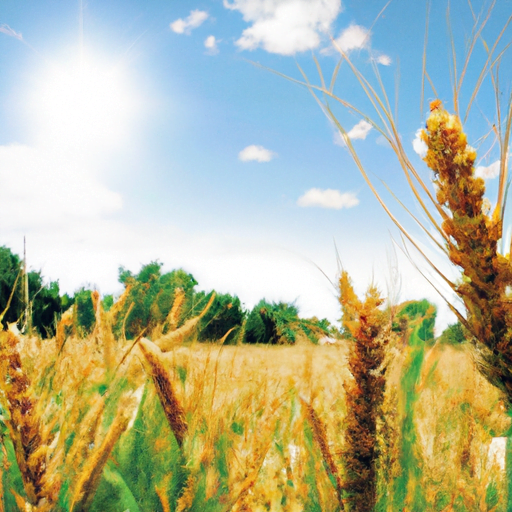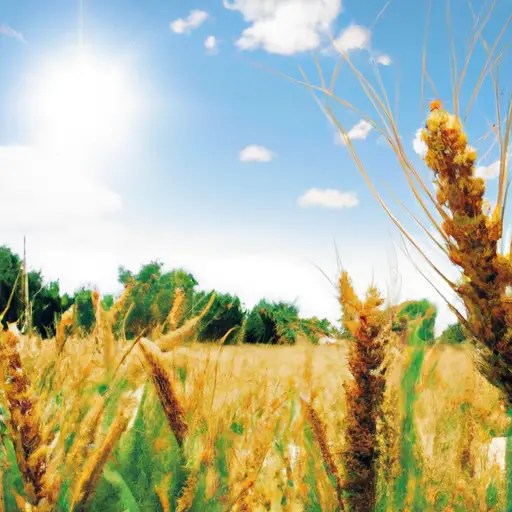So you’re interested in survival and living off the grid, huh? Well, one of the most important aspects of survival is food. But have you ever wondered what the most efficient food for survival is? Like, what will provide you with the most nutrients and calories to keep you going in those tough situations? Don’t worry, I’ve got you covered. In this ultimate guide, we’re going to dive deep into the world of survival food and explore all the options available to you. Get ready to learn everything you need to know about finding the most efficient food for survival.
When it comes to survival, you want to make sure you’re fueling your body with foods that will give you the most bang for your buck. And by that, I mean the most nutrients and energy. Sure, you could survive on just about anything, but if you’re looking to thrive in extreme conditions, you’ll need to be smart about your food choices. In this guide, we’ll discuss a range of options – from canned goods to dried foods to foraging in the wild – and help you understand which ones will provide you with the most efficient nutrition for survival. Trust me, by the end of this article, you’ll have a whole new perspective on what it means to eat for survival.
So, let’s get down to business and explore the world of survival food. We’ll discuss the benefits and drawbacks of various options, talk about the importance of a balanced diet, and even give you tips on how to store and preserve your food for the long haul. Whether you’re planning an epic wilderness adventure or just want to be prepared for any unexpected emergencies, this guide is here to help you find the most efficient food for survival. So grab a notebook and get ready to take some notes, because you’re about to become a survival food expert. When it comes to survival situations, efficient food is essential. Whether you find yourself in a natural disaster, stranded in the wilderness, or facing a long-term emergency, having the right food can make all the difference. In this ultimate guide, we will explore the factors to consider when choosing survival foods, the advantages and disadvantages of prepackaged options, the benefits of natural foods for survival, and the various methods of food preservation. Additionally, we will discuss how to create a balanced survival food plan, the benefits of growing your own food, alternative protein sources, food storage and safety, and conclude with some key tips for implementing an efficient survival food strategy.

Understanding the Importance of Efficient Food in Survival Situations
In survival situations, access to efficient food becomes crucial. It is not just about satisfying your hunger, but also about meeting your nutritional needs to maintain physical strength and mental clarity. In such situations, where food scarcity may be a reality, having the right type of food becomes vital.
Efficient food provides the necessary nutrients, has a long shelf life, and offers sufficient caloric density to meet your energy requirements. By focusing on these factors, you can ensure that you are well-prepared for any survival scenario.
Factors to Consider in Choosing Survival Foods
When choosing survival foods, there are several factors you should take into consideration.
Nutritional Value and Essential Nutrients
Survival situations require foods that provide essential nutrients to keep your body functioning optimally. Look for high-quality proteins, healthy fats, carbohydrates, vitamins, and minerals. Foods that are rich in these nutrients will enable you to sustain yourself physically and mentally during challenging times.
Shelf Life and Longevity
The shelf life of survival foods is another crucial factor to consider. You need foods that will last for an extended period without spoiling or losing their nutritional value. Look for products with long shelf lives that can withstand various storage conditions. This will ensure that your food remains viable for an extended period, reducing the need for frequent replenishment.
Caloric Density and Energy Requirements
Survival situations demand a lot of physical exertion, meaning your body will require more energy than usual. Choosing foods with high caloric density can help fulfill your increased energy requirements without the need to carry excessive weight. Look for foods that provide a lot of calories per serving, such as nuts, dried fruits, and energy bars.
Prepackaged Survival Foods
Prepackaged survival foods are convenient and specifically designed to meet your nutritional needs in emergency situations. However, there are both advantages and disadvantages to consider.
Advantages and Disadvantages
One of the significant advantages of prepackaged survival foods is their long shelf life. These products are often specially packaged to resist spoilage and degradation, allowing them to last for years. Additionally, these foods are typically nutritionally balanced, ensuring you receive a variety of essential nutrients.
However, prepackaged survival foods can be expensive, particularly when purchasing from popular brands. Additionally, they may contain preservatives and additives, which can impact the overall quality and nutrition of the food. It is essential to carefully read the labels and choose products that align with your nutritional needs and preferences.
Popular Brands and Product Reviews
When it comes to prepackaged survival foods, there are several popular brands to consider. Some well-known options include Wise Company, Mountain House, and Augason Farms. These brands offer a wide range of meals, snacks, and drinks that cater specifically to survival scenarios.
To determine which brand and products are best suited for your needs, it is crucial to read product reviews and gather feedback from other survivalists. Reviews can provide valuable insights into the taste, quality, and overall satisfaction of the products, helping you make an informed decision.
Storage and Selection Tips
Proper storage is essential to maintain the longevity and quality of prepackaged survival foods. Store your food in a cool, dry place away from direct sunlight. Be mindful of potential pests and rodents that could compromise the integrity of your supplies. Additionally, rotate your stock regularly, consuming older items first, and replenishing your storage with fresh products.
When selecting prepackaged survival foods, choose a variety of options to ensure a balanced diet. Include meals that are easy to prepare, require minimal water, and provide maximum nutritional value. This will help you stay well-nourished and energized during challenging times.

Natural Foods for Survival
In addition to prepackaged options, natural foods can provide an excellent alternative for survival situations. Foraging for wild edibles, identifying nutritious plant species, and tips for hunting and fishing can all contribute to your ability to find food in the wilderness.
Foraging for Wild Edibles
Foraging for wild edibles can be a valuable skill in survival situations. Learning to identify edible plants in your region can provide you with a sustainable food source. Look for plants such as dandelions, wild berries, and edible fungi. It is crucial to educate yourself on plant identification and only consume plants you are confident are safe to eat.
Identifying Nutritious Plant Species
When foraging for natural foods, it is essential to focus on plants with high nutritional value. Look for plants that are rich in vitamins, minerals, and proteins. Examples include stinging nettles, lambsquarters, and chickweed, which can be cooked or consumed raw.
Tips for Hunting and Fishing
Hunting and fishing are traditional methods of procuring food in survival scenarios. Learning proper hunting and fishing techniques can significantly increase your chances of success. Develop skills such as tracking, trapping, and fishing to supplement your food supply with fresh meat and fish.
Food Preservation Methods
In survival situations, it is essential to know how to preserve food to extend its shelf life.
Canning and Jarring
Canning and jarring are popular food preservation methods that involve placing food in airtight containers and subjecting them to high heat. This process eliminates bacteria, molds, and yeasts, allowing the food to be stored safely for long periods. It is crucial to follow proper canning and jarring techniques to prevent spoilage.
Dehydration and Freeze-drying
Dehydration and freeze-drying are methods that remove moisture from food, inhibiting the growth of microorganisms. Dehydrated or freeze-dried foods can be rehydrated when needed, providing a lightweight and long-lasting food option. These methods are particularly effective for preserving fruits, vegetables, and meats.
Smoking and Salting
Smoking and salting have been used for centuries to preserve food. Smoking involves exposing food to smoke from burning wood, which imparts flavor while maintaining its shelf life. Salting involves covering food in salt to draw out moisture, inhibiting bacterial growth. Both methods can be effective in preserving meat and fish.
Creating a Balanced Survival Food Plan
To ensure you are adequately prepared for any survival situation, it is essential to create a balanced food plan.
Calculating Daily Caloric and Nutritional Needs
Understanding your daily caloric and nutritional needs is crucial for planning your survival food supply. Consider factors such as your age, gender, activity level, and any specific dietary requirements. By calculating these needs, you can ensure you have enough food to sustain yourself throughout the emergency.
Meal Planning and Recipes
Meal planning and preparation are essential for maintaining a well-rounded diet in survival situations. Create a variety of meal options that include a balance of proteins, carbohydrates, and fats. Consider recipes that are easy to prepare using minimal resources and require little time.
Rotating and Replenishing Supplies
Rotating and replenishing your food supplies is crucial to prevent spoilage and ensure the availability of fresh food. Regularly check expiration dates and consume foods nearing their expiration first. Restock your supplies with fresh food to maintain a consistent and reliable food source.
Growing Your Own Food for Survival
Growing your own food can be a sustainable and cost-effective way to ensure a reliable food supply in survival situations.
Setting Up a Survival Garden
Setting up a survival garden is an effective way to grow your own food. Choose a location with ample sunlight and fertile soil. Consider the types of crops that are suitable for your region and climate. Focus on high-yield, resilient plants that require minimal maintenance, such as tomatoes, peppers, and leafy greens.
Choosing Resilient and High-Yield Crops
Selecting resilient and high-yield crops is essential for maximizing your food production. Look for crops that are resistant to pests, diseases, and adverse weather conditions. Certain varieties of beans, corn, and root vegetables are known for their ability to produce abundant yields.
Cultivating Alternative Protein Sources
In addition to growing fruits and vegetables, consider cultivating alternative protein sources. Raising chickens for eggs, rabbits for meat, or even aquaponics systems for fish and vegetables can provide a renewable and sustainable source of protein in survival situations.
Alternative Protein Sources
When it comes to survival situations, alternative protein sources can be an excellent addition to your food supply.
Insects and Insect-Based Foods
Insects are incredibly rich in protein and can be found abundantly in many regions. Consider incorporating insects into your diet by collecting and preparing edible species such as crickets, mealworms, and grasshoppers. Additionally, there are now insect-based food products available, such as protein bars and snacks.
Plant-Based Protein Alternatives
Plant-based protein alternatives are an excellent option for vegetarian and vegan survivalists. Foods such as beans, lentils, quinoa, and tofu provide essential proteins and can be stored long-term. Incorporating these plant-based options into your survival food plan ensures you have a balanced diet even without animal-based protein sources.
Options for Vegetarian and Vegan Survivalists
For vegetarian and vegan survivalists, there are many viable options for obtaining essential nutrients. In addition to plant-based proteins, stock up on a variety of fruits, vegetables, grains, nuts, and seeds. This will provide you with a well-rounded diet that meets your nutritional needs while avoiding animal products.
Food Storage and Safety
Proper food storage and safety protocols are crucial for maintaining the quality and integrity of your survival food.
Proper Storage Conditions and Containers
Storing your food in the right conditions is essential to prevent spoilage and maintain its quality. Choose cool, dry storage areas away from direct sunlight. Use airtight containers that are resistant to pests and rodents. Vacuum-sealed bags and moisture absorbers can also help prolong shelf life.
Avoiding Contamination and Spoilage
Contamination and spoilage of food can lead to foodborne illnesses and reduce the nutritional value of your supplies. To avoid this, practice good hygiene, especially when handling food. Keep your storage containers clean and regularly inspect your food for signs of spoilage or pest infestation.
Food Safety Tips in Challenging Environments
In challenging environments, such as extreme temperatures or during natural disasters, additional precautions must be taken to ensure food safety. When dealing with perishable foods, prioritize consumption of these items before they spoil. Consider using ice packs or coolers to maintain the temperature of perishable food items in hot weather.
Conclusion
In conclusion, finding the most efficient food for survival requires careful consideration of factors such as nutritional value, shelf life, and caloric density. Whether you choose prepackaged survival foods, forage for natural foods, or grow your own, it is crucial to create a balanced food plan that meets your specific needs.
By understanding food preservation methods, exploring alternative protein sources, and implementing proper storage and safety protocols, you can ensure a reliable and sustainable food supply in any survival situation. Remember to regularly rotate and replenish your supplies to maintain freshness and continue exploring new strategies to enhance your survival food strategy.
By taking the time to plan and prepare, you can maximize your chances of thriving in the face of adversity and ensure you have the most efficient food for survival.




